The media has been full of reports that this year, the first of the huge and influential baby-boom generation turns 60. Closer to home, the median age of the members of the Society of Petroleum Engineers and the American Association of Petroleum Geologists is 53, so they are not far behind. They'll turn 60 in roughly the same amount of time it takes a major to find, appraise, develop and bring onstream an ultra-deepwater discovery. But until then, boy howdy. Nabors Industries is so busy it has ordered 51 new rigs to be built in China. Our cover story this month illuminates just how stretched all the service and supply companies are, and what they are doing about it. Can large companies afford to offer buyout packages to so many retirees who have given so much, and who all retire in the same five-year period? Even if they do, many of these geologists, engineers and landmen will not be gone for long-they will find themselves in lucrative consulting roles with their former employers for years to come. After all, somebody has to find more oil and gas to bridge the gap to the eventuality-in 20 years?-that we transition away from oil as a transportation fuel. A manager working for a major told me recently that the company strongly believes the world will transition away from crude oil long before it runs out, due to societal and environmental pressures and a much-higher oil price. For the rest of this decade, though, oil and gas are hot commodities whose worth is rising in dollar terms, and psychological ones as well. Katrina, Rita and Middle East politics-not to mention a flurry of new books and movies-have given the general public and politicians a new appreciation for the importance of oil and gas to our economy and lifestyle. Their scarcity and the difficulty of finding and producing them are becoming better known. As the worth of oil and gas rises, the investment community has a renewed appreciation for the returns these commodities now generate, and so, it flocks to the industry in myriad ways. Capital is so abundant as to be the least of our worries-indeed, it causes the new worry that poor decisions could soon be made, eventually souring investors' mood. So much capital is chasing so few good deals that at the IPAA's private capital conference in Houston in January, the majority of the 300-odd attendees were themselves capital providers and financial advisors, not E&P companies actually seeking capital. Deal-chasing is at a fevered pitch. Like baby boomers wearing relaxed-fit jeans as their waistlines expand, deal criteria are relaxing and values for nonproducing reserves are growing. Lenders and investors are starting to branch out, therefore, to fund more small prospect-generation shops, companies with exploration ideas in their portfolios, and internationally flavored projects. "I never saw so many zeroes," commented one observer at the conference. Indeed. Cosco Capital Management estimates that in the past two years, energy private-capital firms have raised $8.5 billion. Danny Weingeist of Kayne Anderson Capital Advisors noted, "Larger funds necessitate larger transactions and/or more portfolio companies. Rule-of-thumb metrics don't make sense anymore." There are roughly 8,000 hedge funds in the U.S. now managing assets totaling $1 trillion. During the past five years, their interest in energy has grown, according to Russell Weinberg of Energy Capital Solutions, the Dallas-based investment banker that has done 20 deals with hedge funds in the past four years. In the past two years, energy-related companies have raised the most capital from hedge funds of any industry, mostly through PIPE, or private investments in public equity, deals. Energy resources and related made up 11% of PIPE deals in 2004 and 16.9% of all PIPEs in 2005, Weinberg said. "Even smaller hedge funds of $300-, $400- or $500 million have set aside 5% to 10% of their total assets for alternative investments such as energy." In the public markets, oil and gas companies' issuance of equity and equity-linked securities has mushroomed, from $3.3 billion in 2002 to $14.2 billion last year, according to JPMorgan Chase's Vean Gregg. Not to throw a wet blanket on this fire, but let's not forget that what goes up could come down. The E&P analysts at A.G. Edwards reminded us in their late-December E&P stock update and outlook that many factors come into play. Declining oil and gas prices, or company-specific drilling opportunities and results, not to mention the performance of the broader stock market, could be risks to the current rosy glow. Can you say warm winter? Too, multiples are high and a natural correction could be inevitable, especially if hedge-fund investors change their momentum. At the IPAA conference, one financial intermediary noted that a potential investor told him because energy was so hot, he would not invest in it at this time.
Recommended Reading
Matador Stock Offering to Pay for New Permian A&D—Analyst
2024-03-26 - Matador Resources is offering more than 5 million shares of stock for proceeds of $347 million to pay for newly disclosed transactions in Texas and New Mexico.
PrairieSky Adds $6.4MM in Mannville Royalty Interests, Reduces Debt
2024-04-23 - PrairieSky Royalty said the acquisition was funded with excess earnings from the CA$83 million (US$60.75 million) generated from operations.
JMR Services, A-Plus P&A to Merge Companies
2024-03-05 - The combined organization will operate under JMR Services and aims to become the largest pure-play plug and abandonment company in the nation.
New Fortress Energy Sells Two Power Plants to Puerto Rico
2024-03-18 - New Fortress Energy sold two power plants to the Puerto Rico Electric Power Authority to provide cleaner and lower cost energy to the island.
Kimmeridge Fast Forwards on SilverBow with Takeover Bid
2024-03-13 - Investment firm Kimmeridge Energy Management, which first asked for additional SilverBow Resources board seats, has followed up with a buyout offer. A deal would make a nearly 1 Bcfe/d Eagle Ford pureplay.





